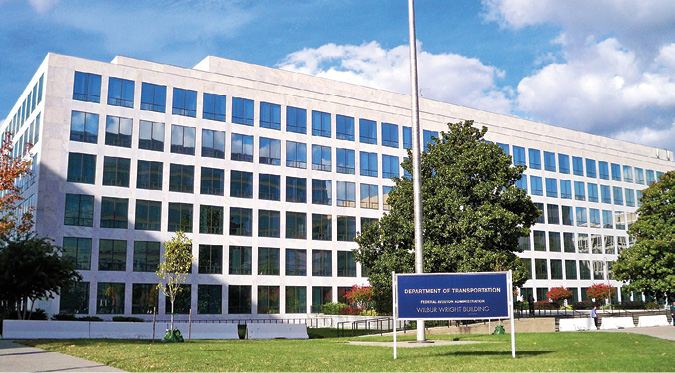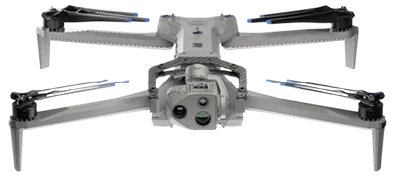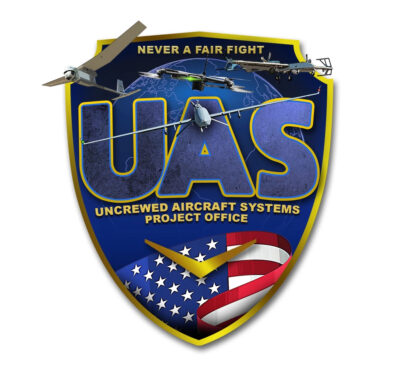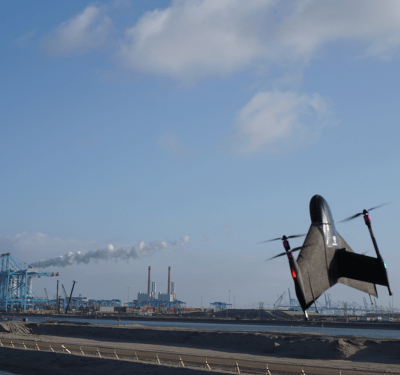Recent federal appropriations have significantly focused on drone and advanced air mobility (AAM) technologies. The FAA Reauthorization Act includes provisions to enhance infrastructure, expand existing programs and establish new regualtory frameworks for BVLOS flights. Concurrently, the Defense Innovation Unit (DIU) is breaking down barriers to DoD’s expanded commercial technology deployment. Recent changes to the Blue UAS program open up additional opportunities for commercial firms, and the first tranche of Replicator contract awards demonstrate momentum in this vital area of development.

Final Passage of FAA Reauthorization Act
The FAA Reauthorization Act was passed by the House and the Senate in May. Provisions in the bill relevant to UAS and Advanced Air Mobility (AAM) expansion include: Airport and vertiport infrastructure improvements, development of a comprehensive FAA plan on UAS automation in the NAS; extension of the BEYOND program; rulemaking and risk assessment methodology for BVLOS flights; a ban on federal procurement of drones manufactured in the People’s Republic of China (PRC); cyber threat preparedness planning.
Also included in the FAA Reauthorization Act: Drone infrastructure inspection pilot program and federal training/grants; special authority for the transport of hazardous materials by commercial UAVs; establishment of a FAA Airspace Modernization Office, responsible for the modernization of the NAS and a Center for Advanced Aviation Technologies, dedicated to the adoption of advanced aviation technologies. Part 107 waiver improvements are mapped out using “a performance- and risk-based approach in reviewing waiver requests” and “to improve the application and review process, by no longer requiring the use of open-ended prompts”, in an effort to simplify the application process. This section also requires the FAA “to recognize the safety enhancements of controlled access to property over which an unmanned aircraft flies in assessing whether to approve a waiver”.
Also included are the initiation of a rulemaking process for vertical flight and powered-lift aircraft; establishing procedures for approval of third-party UTM providers; discretion to expand the UAS test range program from 7 to 9 test ranges, including a new test range on the Gulf Coast. Finally, an “alternative means of compliance” for Remote ID is included in the Act, including network-based remote identification.

DIU Makes “Significant Changes” to Blue UAS Approved Manufacturer Program

The DoD’s Defense Innovation Unit (DIU) has announced “significant changes” to the Blue UAS framework, “in response to the evolving needs of the warfighter”. Trent Emeneker, DIU Blue UAS program manager said, “Global events make plain the urgent need to continue to rapidly upgrade and expand options for the warfighter. As drone use increases in conflicts, DIU’s “Blue List”, a list of cleared and approved drones, must be more agile and responsive to both DoD and commercial partner needs. To do that, the Blue List will focus on providing needed hardware capabilities while facilitating the rapid software development vital to creating and maintaining success on the battlefield.”
On May 28th, the Skydio X10D, Anduril Industries Ghost / Ghost X, and Freefly Systems Astro were added to the Blue List. The changes “will reduce administrative burdens with not having to pursue Exceptions to Policy (ETP’s) in order to use the payloads and capabilities they need. The updated Blue UAS Framework List will provide approved options within the bounds of existing Authorizations to Operate (ATO)”, the DIU said in a release.
Beginning in late 2024, there will be an annual competitive refresh for the Blue UAS List. The DIU announcement says, “We will incorporate end user feedback, with tactical level operators providing hands-on flight and performance evaluation that will go into the overall scoring to ensure we are delivering what is needed by end users today.”
The DIU also announced initiatives “to deliver increased capabilities to the warfighter and streamline processes for our commercial partners. First, DIU is providing continuous monitoring of software to reduce update approval time providing updated capabilities to the warfighter in close to real time. This will reduce DIU’s average of 45 days to no more than 96 hours. As a comparison, typical DoD software monitoring and update approval time takes 12+ months. A second effort is to allow transfer of critical component information from AUVSI’s Green UAS to Blue UAS Framework, which is intended to provide additional optionality to end users.”
AUVSI and DIU Publish Secure Drone Procurement Guidance for Government Agencies, Public Safety, Industry

The Association for Uncrewed Vehicle Systems International (AUVSI) published a memo, with validation from the DIU, giving procurement guidance and recommendations for federal government agencies; state, local, and tribal government agencies; public safety agencies; and private industry conducting sensitive missions using drones.
The memo follows the passage of the American Security Drone Act (ASDA) into law in December 2023 and publication of a joint memo from the FBI and CISA in January 2024 titled, “Cybersecurity Guidance: Chinese-Manufactured Unmanned Aircraft Systems (UAS).”
Casie Ocaña, Director, Trusted Programs at AUVSI said: “We’ve seen an increased focus from industry and end-users on drone security, but both private and public entities face challenges in determining which regulations, standards, or guidance they must or should abide by in their procurement processes. Our goal is for this document to provide clarity on technology solutions that meet users’ needs.”
The memo’s release also follows the recent signing of a Memorandum of Understanding (MOU) between DIU and AUVSI to create a process for drone component manufacturers holding Green UAS certification to share their data directly with DIU. The objective is to facilitate the inclusion of certified components on DIU’s Blue UAS Framework list, streamlining certification reviews for component manufacturers.
David Michelson, Director of the autonomy portfolio at DIU, said: “The intent behind our effort with AUVSI is to increase availability of NDAA verified UAS components to the uncrewed industry at large and streamline the process for Blue UAS consideration. As we look ahead to a refresh of vendors and platforms on the Blue UAS Cleared List later this year, DIU is prioritizing UAS that have already been vetted as meeting the highest levels of cybersecurity and NDAA supply chain requirements.”
AUVSI expects to announce the certification of additional UAS platforms as Green approved in the near term, which will expand the offerings of vetted UAS that serve sectors in public safety, critical infrastructure, and agriculture.

DoD Announces First Tranche of Replicator Program Contracts
The U.S. Department of Defense has announced the first tranche of capabilities for the Replicator initiative. Deputy Secretary of Defense Kathleen Hicks announced the first series of fielded technologies under this innovative program aimed at incorporating commercial technology into defense capabilities. The initiative has commenced with a focus on All-Domain Attritable Autonomous (ADA2) systems. The initial tranche of the Replicator initiative includes an array of unmanned systems, such as surface vehicles (USV), aerial systems (UAS), and counter-uncrewed aerial systems (c-UAS). In the air domain, the Switchblade-600 loitering munition from AeroVironment Inc. will be accelerated for field deployment. These drones, which have demonstrated their effectiveness in Ukraine, are set to significantly enhance U.S. military capabilities.
This ambitious project has secured a substantial funding provision, with about $500 million allocated for fiscal year 2024, bolstered by the defense appropriations bill and additional funding from Defense-wide sources. The Department has also requested a comparable amount for FY25, underscoring a commitment to harnessing advanced technology for defense applications.
Deputy Secretary Hicks emphasized the transformative nature of the Replicator initiative: “We are taking an important step toward strengthening our defense and technology industrial base,” she stated. “By investing in scalable production for these critical capabilities, we are demonstrating the Department’s ability to break down barriers to scaling innovation at speed, not just for ADA2 systems but across our ability to develop new capabilities and processes for the Department and key stakeholders, including Congress.”
Admiral Samuel Paparo, commander of U.S. Indo-Pacific Command, highlighted the strategic importance of these advancements: “The entire Department has come together to help make this a reality, marking a critical step in delivering the capabilities we need, at the scale and speed required, to continue securing a free and open Indo-Pacific,” he remarked.
In the maritime domain, the initiative is expanding the vendor base for USVs through the newly introduced Production-Ready, Inexpensive, Maritime Expeditionary (PRIME) Commercial Solutions Opening (CSO). Launched in January 2024, the PRIME CSO has already received over one hundred proposals from tech companies, setting the stage for multiple contract awards this summer.
Doug Beck, Director of the Defense Innovation Unit, highlighted the collaborative nature of the initiative: “Meeting the strategic imperatives facing the nation requires that we harness the very best of America’s commercial technology alongside our traditional sources of defense capabilities,” he said. “Replicator is doing just that, and that is why we at DIU are proud to work with our partners from across the Department of Defense to make it a reality.”
Admiral Christopher Grady, Vice Chairman of the Joint Chiefs of Staff, looked to the future of the Replicator initiative: “This is just the beginning. Replicator is helping us jumpstart the delivery of critical capabilities at scale. We will build on that momentum with industry partners to deliver what the warfighter needs, and remove barriers to doing so again and again.”
As the Replicator initiative continues to evolve, its impact on the technological and operational landscape of the U.S. military is expected to be profound, offering new solutions in ADA2 systems and beyond, thus reinforcing the nation’s defense capabilities and strategic preparedness.
Air Force and DIU Partner on Enterprise Test Vehicle (ETV) Project with 4 Commercial Firms
The U.S. Air Force Armament Directorate (AFLCMC/EB) and the DIU) have announced a collaborative effort, the Enterprise Test Vehicle (ETV) Project, to leverage commercial technologies for a new class of drones. Focus on Modularity and Affordability
The ETV aims to demonstrate modularity for subsystem upgrades, enabling rapid testing and integration of new technologies. Additionally, the project prioritizes cost-effective, high-rate production through the use of commercial off-the-shelf (COTS) components and modern design for manufacturing (DfM) approaches. This ensures the air vehicles are optimized for their mission, minimizing production costs and avoiding over-engineering.
Four companies – Anduril Industries, Integrated Solutions for Systems, Inc., Leidos Dynetics, and Zone 5 Technologies – were selected from over 100 applicants to develop prototype solutions. Initial flight demonstrations are expected within seven months, with the most promising design chosen for further development towards a rapidly scalable production variant.
The ETV prototypes will utilize an open systems architecture reference design, facilitating future upgrades and rapid integration of new subsystems. This modularity, coupled with the ability for mass deployment via various launch methods, aims to overwhelm adversaries.
“The ETV presents an opportunity to leverage promising ideas from industry to create and refine affordable designs for test capabilities that can be produced on a relevant timeline,” said Assistant Secretary of the Air Force for Acquisition, Technology and Logistics Andrew Hunter. DIU Director Doug Beck echoed this sentiment, highlighting the project’s focus on speed, scale, and leveraging commercial technology to deliver cost-effective, rapidly deployable autonomous systems.
The ETV project serves as a springboard for broader initiatives within the Department of Defense. DIU aims to accelerate autonomy across various domains, including adopting commercial solutions and improving defensive capabilities against adversarial autonomous systems.





